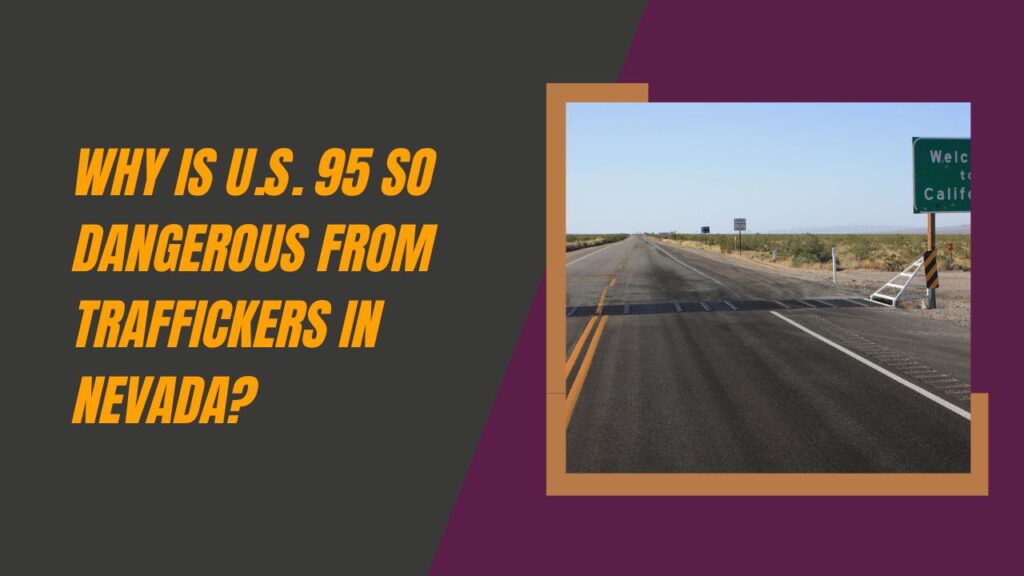Why Is U.S. 95 So Dangerous from Traffickers In Nevada? U.S. 95 in Nevada is a dangerous route for traffickers due to its remote, less-patrolled sections, making it an ideal corridor for transporting illicit goods.
U.S. Highway 95, a major north-south route in the United States, is known for connecting California to Idaho, crossing through Nevada’s most remote and desolate stretches.
While it is a crucial transportation corridor, it also holds a darker reputation due to its involvement in drug trafficking and illegal activities. U.S. 95, which weaves through a variety of terrains, has become a highway of choice for drug traffickers.
The highway’s combination of isolation, limited law enforcement presence, and proximity to drug-producing regions makes it one of the most dangerous roads in Nevada for trafficking.
In this article, we will explore why U.S. 95 is so dangerous, its role in drug trafficking, the impact on local communities, and potential solutions to improve safety on this critical route.
What Is U.S. 95?
Route and Key Areas
U.S. Highway 95 runs from the Mexican border in California, through Nevada, and all the way to the Canadian border in Idaho. [Why Is U.S. 95 So Dangerous from Traffickers In Nevada?]
In Nevada, it connects major cities such as Las Vegas, Tonopah, and Reno, and serves as a key route for both local commuters and long-distance travelers.
The highway covers a range of landscapes, from desert expanses to mountainous regions, and provides a direct route to many of Nevada’s rural communities. It is a vital artery for trade and travel, facilitating the movement of goods and people across the state.
While its significance as a major transportation route cannot be understated, it is also essential to consider the highway’s vulnerabilities.
The sections of U.S. 95 that pass through Nevada’s most remote regions have earned the highway a reputation as a prime route for illicit trafficking, particularly drug trafficking.
Significance of U.S. 95
The highway’s importance cannot be overstated. For local residents and businesses, U.S. 95 is the lifeblood of trade and commerce. It connects smaller communities that otherwise would have limited access to larger urban centers.
Long-distance truckers also use it as a convenient passage between states. For traffickers, however, the isolation that makes it an essential route for goods and services is also what makes it so dangerous.
The highway’s unique position along a busy trade corridor between Mexico and the United States creates an opportunity for traffickers to transport illegal goods discreetly. [Why Is U.S. 95 So Dangerous from Traffickers In Nevada?]
Many of these traffickers use the highway to bring drugs into Nevada, moving them toward distribution centers in larger cities like Las Vegas or further north.
The isolated, sparsely populated areas along the route provide cover for criminals, and the highway’s connection to well-known drug entry points makes it a prime corridor for illicit activity.
The Geography of U.S. 95 in Nevada
Remote and Isolated Sections
One of the most significant factors contributing to the highway’s dangerous reputation is its geography. As U.S. 95 cuts through Nevada, much of it runs through vast stretches of desert, remote mountain passes, and rural areas with few towns or major intersections.
While this isolation makes the highway convenient for travelers seeking to avoid heavy urban traffic, it also creates a perfect environment for drug traffickers who need to move large quantities of illicit goods across long distances without attracting attention.
Nevada’s rugged terrain and vast open spaces offer traffickers the opportunity to use smaller, less detectable vehicles and low-profile tactics to evade detection. [Why Is U.S. 95 So Dangerous from Traffickers In Nevada?]
This is in stark contrast to highways that pass through urban or suburban areas, where heavy traffic, more law enforcement, and increased surveillance make illegal operations harder to conceal.
Challenges in Monitoring
The remoteness of U.S. 95 creates serious challenges for monitoring and law enforcement. The long stretches of open desert between major towns leave the highway vulnerable to exploitation by traffickers.
With limited infrastructure for surveillance, it is much more difficult for authorities to monitor traffic on the highway consistently. [Why Is U.S. 95 So Dangerous from Traffickers In Nevada?]
Many stretches of the road are hundreds of miles from the nearest major city, making it difficult for law enforcement to perform regular patrols or conduct checkpoints.
The limited presence of law enforcement in these areas means traffickers can use the highway at night or during off-peak hours to transport illegal substances, taking advantage of the lack of visibility and monitoring.
Furthermore, the absence of nearby major police precincts or resources in rural areas means that when law enforcement does respond to incidents, it may take longer to mobilize and act.
This lack of immediate intervention makes U.S. 95 an ideal route for criminal activities that operate under the radar. [Why Is U.S. 95 So Dangerous from Traffickers In Nevada?]
The Role of U.S. 95 in Drug Trafficking
Gateway for Traffickers
U.S. 95’s location makes it a key artery for drug trafficking operations, particularly those moving narcotics from Mexico into the U.S. California’s proximity to Mexico, where much of the U.S. drug supply originates, creates an obvious gateway for drugs to enter the country.
Once illicit substances cross the border, they are often moved through California into Nevada.
From there, traffickers use U.S. 95 to take these drugs into larger cities or further north into other parts of the country. [Why Is U.S. 95 So Dangerous from Traffickers In Nevada?]
In addition to its proximity to known entry points for illegal drugs, U.S. 95 is also conveniently situated in Nevada, where criminal organizations know they can operate without facing the same scrutiny they would encounter in more densely populated states.
As a result, traffickers can use this route to move drugs such as methamphetamine, heroin, and marijuana more freely, avoiding tighter regulations and law enforcement surveillance on other major highways.
Exploiting the Highway
Traffickers exploit U.S. 95 due to the lack of surveillance and its sparse traffic flow. The long, unpopulated stretches give traffickers the freedom to transport drugs using smaller, less conspicuous vehicles, such as passenger cars or vans.
These vehicles can easily blend in with long-distance travelers, especially when traffickers choose off-peak travel times or alternate routes that bypass major checkpoints.
In addition to traditional drug trafficking methods, some criminals may also take advantage of the rural nature of U.S. 95 to establish clandestine drug distribution operations or stash houses along the highway.
Traffickers can use these isolated locations as storage points for illicit substances, waiting until the right time to move the drugs further down the route. [Why Is U.S. 95 So Dangerous from Traffickers In Nevada?]
This decentralized approach to trafficking further complicates law enforcement’s ability to detect and dismantle trafficking operations.
Law Enforcement Efforts to Combat Trafficking
Action Taken by Authorities
Recognizing the dangers posed by U.S. 95, law enforcement agencies in Nevada have taken a series of steps to combat trafficking along this highway. [Why Is U.S. 95 So Dangerous from Traffickers In Nevada?]
Federal agencies such as the Drug Enforcement Administration (DEA), in collaboration with state and local law enforcement, have implemented operations targeting trafficking routes like U.S. 95.
These operations are designed to disrupt the flow of illegal goods across the highway and curb the violence associated with trafficking.
Local police departments and Nevada Highway Patrol also conduct roadblocks and inspections, particularly in areas that have been flagged for high levels of illegal activity.
However, with such vast areas to cover, authorities rely on advanced technology to enhance their monitoring capabilities.
Surveillance cameras, automatic license plate readers, and even drones have been employed to help detect suspicious vehicles and monitor traffic patterns along the highway.
Challenges Faced
Despite these efforts, law enforcement faces significant hurdles in curbing trafficking along U.S. 95. One of the primary obstacles is the sheer scale of the area that needs to be monitored.
The highway spans hundreds of miles across open desert land with few towns or police stations to provide assistance.
This means that even when law enforcement does detect an issue, it can take hours for units to respond, giving traffickers a significant head start.
Another challenge is that traffickers are increasingly using new methods and technologies to evade detection. [Why Is U.S. 95 So Dangerous from Traffickers In Nevada?]
From hidden compartments in vehicles to remote-controlled drone drops, traffickers are constantly evolving their strategies to stay ahead of the authorities.
This cat-and-mouse dynamic makes it difficult for law enforcement to keep up, requiring constant innovation and adaptation.
The Impact on Local Communities
Community Concerns
For residents living along U.S. 95, the increase in drug trafficking has had a significant impact on safety and quality of life. [Why Is U.S. 95 So Dangerous from Traffickers In Nevada?]
Communities near trafficking routes are often exposed to higher levels of violence and crime, as rival traffickers fight for control of territories or as individuals involved in trafficking engage in dangerous behavior.
The presence of drug activity can lead to spikes in theft, assault, and other criminal behaviors that make residents feel unsafe in their own homes.
In addition to direct violence, the presence of drugs can disrupt local economies. Small towns along U.S. 95 may experience a reduction in tourism or business activity as people avoid areas known for criminal activity.
Local law enforcement and community leaders may struggle to maintain a sense of security, as they face off against a large and organized criminal network.
Local Law Enforcement
Local police departments and sheriff’s offices in rural areas face particular difficulties in dealing with the problem. [Why Is U.S. 95 So Dangerous from Traffickers In Nevada?]
These departments often lack the resources to confront the scale of trafficking operations seen along U.S. 95. The sparsity of police stations, coupled with a lack of specialized drug enforcement units, makes it difficult to tackle the issue at the local level.
Many rural areas are simply understaffed or underfunded, which means they must rely on state and federal assistance to address trafficking concerns.
What Can Be Done to Improve Safety on U.S. 95?
Increased Surveillance
One of the most effective ways to curb trafficking along U.S. 95 is through the implementation of enhanced surveillance technologies. [Why Is U.S. 95 So Dangerous from Traffickers In Nevada?]
Automated license plate readers, drones, and remote camera systems can provide real-time monitoring of vehicles traveling along the highway.
These tools allow law enforcement to track suspicious vehicles without needing to have a physical presence on every stretch of road, making it easier to intercept traffickers before they reach their destinations.
Enhanced Law Enforcement Resources
Increasing funding and resources for local law enforcement agencies could help address the problem more effectively. [Why Is U.S. 95 So Dangerous from Traffickers In Nevada?]
By providing additional manpower, better equipment, and specialized training, authorities can improve their ability to detect and disrupt trafficking operations.
Additionally, creating task forces specifically dedicated to monitoring highways like U.S. 95 would allow for better coordination and quicker responses to trafficking incidents.
Community Collaboration
Communities along U.S. 95 can play a vital role in combating trafficking. Local residents are often the first to notice suspicious activity, and their involvement in reporting drug-related incidents can help authorities take action.
Education programs that raise awareness about the dangers of trafficking and encourage residents to report unusual activity can be instrumental in reducing criminal behavior in these areas.
Conclusion
U.S. 95’s remote geography, coupled with its position as a major trade route, makes it an attractive option for traffickers moving illicit goods across the United States.
The highway’s isolation, limited law enforcement presence, and proximity to drug-producing regions contribute to its dangerous reputation. [Why Is U.S. 95 So Dangerous from Traffickers In Nevada?]
While law enforcement has taken significant steps to address trafficking, the vastness of the area and the ever-evolving methods used by traffickers pose substantial challenges.
Increased surveillance, enhanced law enforcement resources, and greater community involvement can help curb the dangers associated with U.S. 95 and ensure that it remains a safe route for residents and travelers alike.
See Also: Why Is The First Descendant Loading So Slow?
FAQs
Why is U.S. 95 used by traffickers?
U.S. 95 is used by traffickers due to its remote, less-patrolled sections that provide a safer route for transporting illicit substances.
What substances are typically trafficked on U.S. 95?
Commonly trafficked substances along U.S. 95 include methamphetamine, heroin, cocaine, and marijuana. [Why Is U.S. 95 So Dangerous from Traffickers In Nevada?]
What steps are being taken by authorities to stop trafficking on U.S. 95?
Authorities have implemented specialized task forces, road checkpoints, and surveillance measures to combat trafficking along U.S. 95.
How can local communities help in the fight against trafficking?
Local communities can support law enforcement by reporting suspicious activity and participating in outreach programs designed to prevent trafficking.

Hi, I’m Fernando Pham, and welcome to WhyDetails.com! I’m from San Francisco, and I love exploring questions and sharing answers through my blog.



